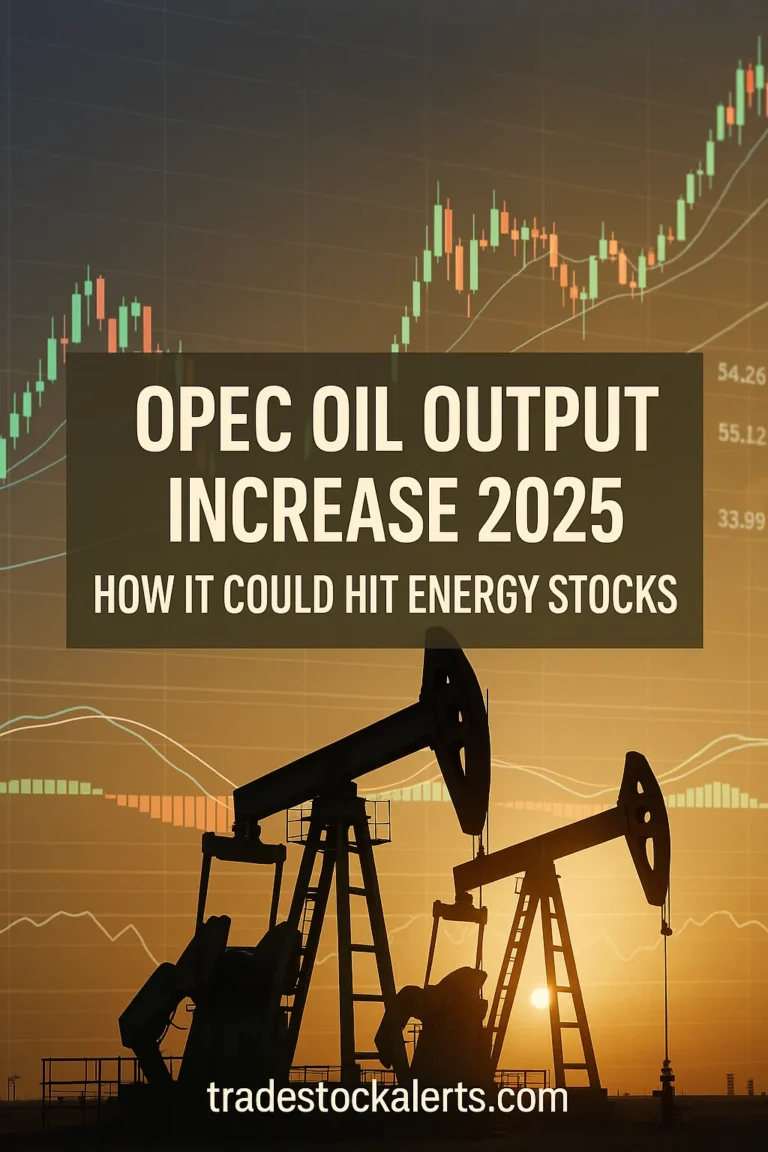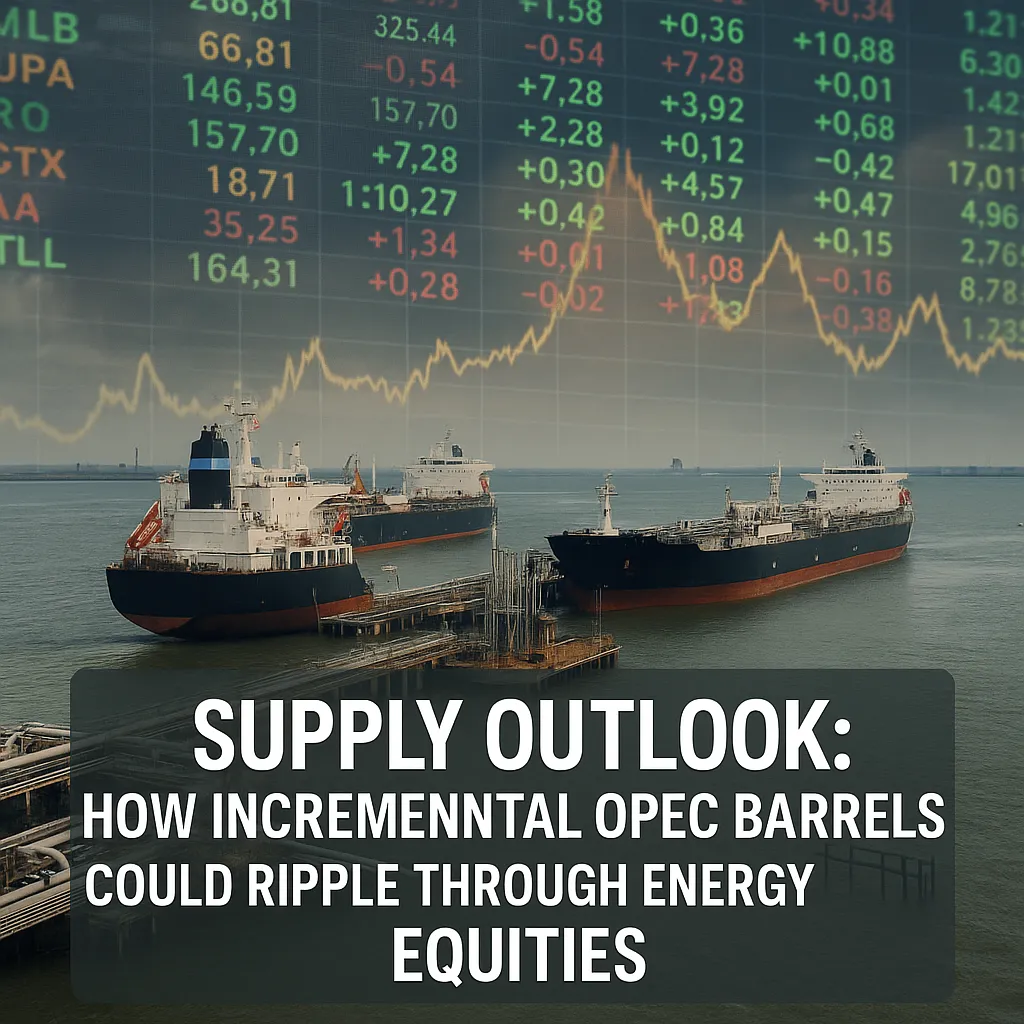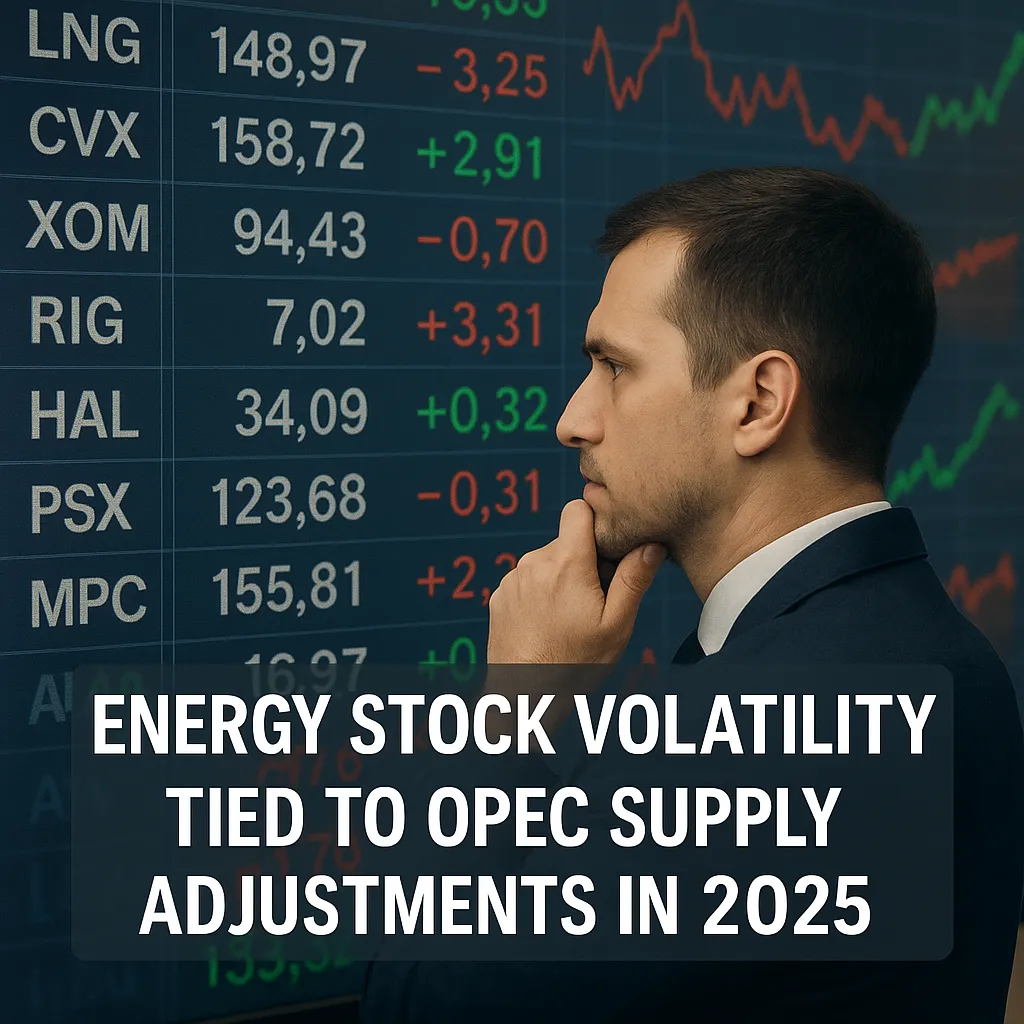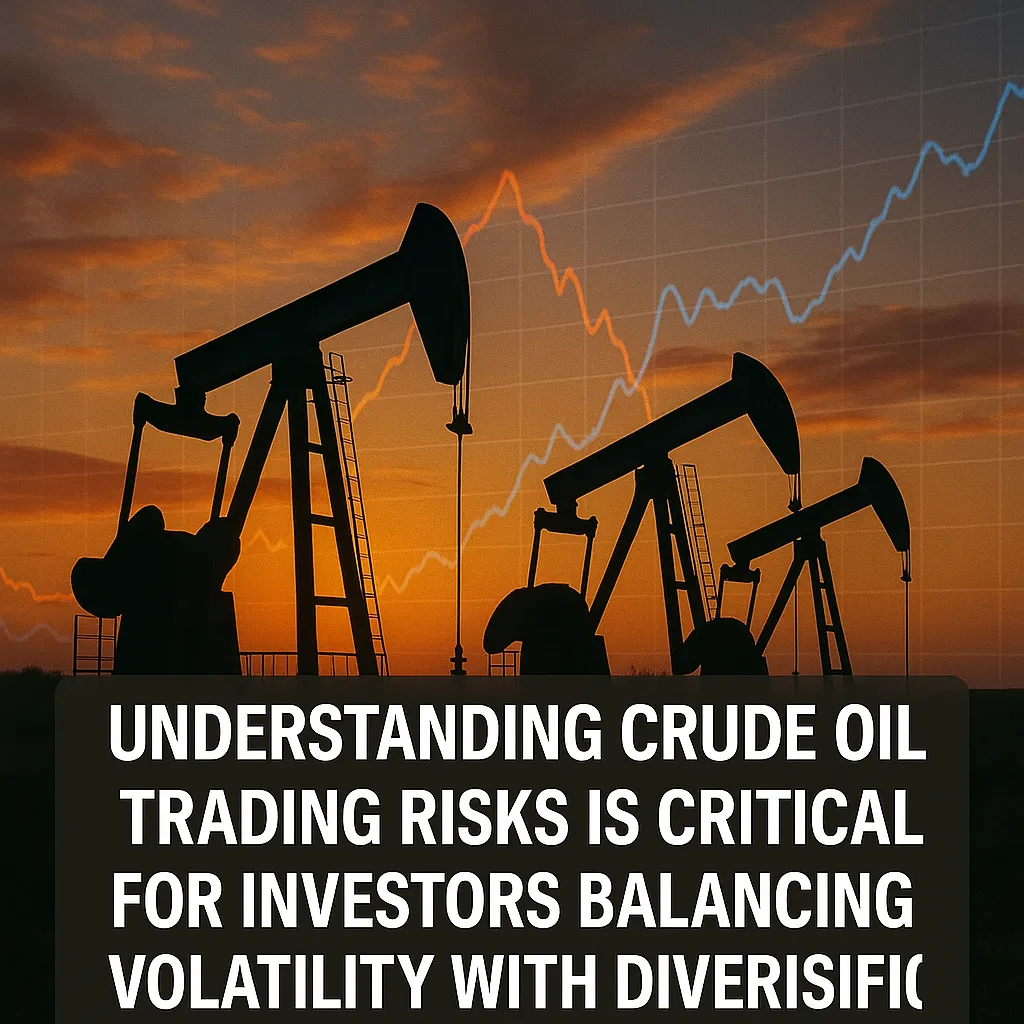
OPEC’s Oil Output Plans: How the 2025 Increase Could Hit Energy Stocks
OPEC Production Forecast 2025 and Market Reactions
The announcement of the OPEC oil output increase 2025 energy stocks strategy has already begun to ripple through global markets, and investors are paying close attention to every detail of the official OPEC production forecast 2025. When the world’s most influential oil cartel signals an intention to bring additional supply online, the implications extend far beyond crude oil prices alone. Traders know that oil does not exist in a vacuum—it is the single most important commodity underpinning transportation, manufacturing, shipping, and even consumer goods, which means that changes in supply can quickly cascade across financial markets, producing volatility in energy stocks as well as in other correlated sectors such as airlines, chemicals, and industrials. In many cases, it is not simply the volume of barrels OPEC adds to the market that matters, but how traders and speculators interpret the signal, and whether they believe demand in 2025 will be strong enough to absorb these additional supplies without triggering sharp downside pressure in futures contracts.
Historical precedent also plays a major role in shaping current expectations. When OPEC last attempted to raise output aggressively during a period of uncertain demand growth, oil prices experienced a multi-month slide that wiped billions off the market capitalization of integrated oil majors like ExxonMobil and Chevron. However, the longer-term effects were more nuanced, as some refiners and transport companies benefited from cheaper feedstock costs. This example underscores a critical point for today’s traders: the link between the OPEC oil output increase 2025 energy stocks narrative and actual equity performance is complex, and while headline prices tend to capture the market’s attention, it is the distribution of winners and losers within the sector that ultimately defines investment opportunities. For this reason, analysts at Reuters and Bloomberg have stressed that investors must be careful not to assume a one-directional relationship between oil supply growth and stock valuations, since correlations often break down under certain macroeconomic conditions.
Another important factor is how geopolitical considerations intersect with market fundamentals. While the OPEC production forecast 2025 highlights supply increases, it does not fully account for possible disruptions in other oil-producing regions. For example, political instability in the Middle East, sanctions in Russia and Iran, or unexpected outages in Africa could quickly offset any planned increases, creating conditions where actual delivered supply falls short of projections. This risk of discrepancy between forecast and realized production is one of the many crude oil trading risks that active traders and institutional investors must manage carefully. Moreover, because oil is priced globally, even localized conflicts can result in price spikes that ripple through markets worldwide, leaving energy stocks exposed to sudden bouts of volatility that are extremely difficult to hedge against without advanced options strategies.
From a structural perspective, the implications of an OPEC oil output increase 2025 energy stocks scenario extend beyond daily spot prices and touch on the long-term viability of energy investments. As investors increasingly allocate capital toward renewables, clean technology, and diversified portfolios, the energy sector is under pressure to prove that it can still deliver stable returns despite cyclical supply increases. This is why major institutions are closely tracking how oil prices impact on stocks at the sector-wide level. If valuations of oil majors are compressed while renewable-linked equities hold firm, the result could accelerate capital rotation away from traditional energy, adding another layer of strategic complexity for portfolio managers heading into 2025. Traders seeking to profit from shorter-term swings may focus on momentum signals and earnings reports, while long-term investors may decide that a hedged allocation, balanced between fossil fuels and alternative energy, offers the best risk-adjusted outcome.

For investors who want to position early, reviewing internal analysis on sector crossovers can provide deeper insight. Consider exploring our coverage of Critical Metals EV Boom Investing, which highlights how energy diversification plays a role in long-term strategy. Shorter-term traders can gain additional perspective by following our Swing Trade Alerts, where we track volatility signals tied to oil and gas, and for a broader view, our daily roundups at Daily Stock Picks often include top-moving energy names reacting to OPEC headlines.
Authoritative sources worth monitoring for updated information include OPEC.org (official releases), Reuters Energy (real-time reporting), Bloomberg Energy (in-depth analysis), CNBC Energy (market commentary), Financial Times Commodities (global coverage), Energy Information Administration (data and statistics), and Investopedia (educational background).
How Oil Prices Impact on Stocks in 2025
The connection between oil prices and equity markets is not only historical but deeply structural, which is why the OPEC oil output increase 2025 energy stocks announcement has triggered so much speculation. When OPEC signals higher production, the immediate assumption is that crude oil prices may come under pressure, since supply growth often outweighs short-term demand growth. However, the reality is more nuanced. A sharp decline in crude prices can weigh heavily on the earnings of upstream producers—companies like ExxonMobil, Chevron, and Occidental Petroleum, whose revenues depend directly on extracting and selling oil at profitable margins. At the same time, a drop in crude prices can benefit downstream players such as refiners, shipping firms, and airlines, as their primary input costs are reduced, potentially improving margins even as broader energy indices experience volatility.
The deeper lesson for investors lies in understanding how oil prices impact on stocks at different points along the energy value chain. For example, integrated oil majors are somewhat insulated because they operate in both upstream and downstream segments, but independent shale drillers are highly vulnerable, while transportation companies may see windfalls from lower fuel costs. In 2025, with the OPEC production forecast 2025 pointing toward higher-than-expected supply growth, traders must be prepared for significant dispersion between winners and losers. This makes stock selection more critical than ever before. Passive exposure through broad energy ETFs could dilute potential gains, while active strategies—such as swing trading individual equities—allow investors to capitalize on volatility more effectively. For this reason, many traders are closely monitoring our Swing Trade Alerts, which highlight setups in the energy sector triggered by changes in crude futures curves, inventory reports, and OPEC policy statements.
Another layer of complexity comes from macroeconomic context. While OPEC’s decision will influence supply, global demand in 2025 is expected to be shaped by slowing growth in China, potential recessions in parts of Europe, and ongoing debates around U.S. monetary policy. If demand proves weaker than expected, the OPEC oil output increase 2025 energy stocks scenario could lead to prolonged downward pressure on prices, leaving energy stocks exposed to both declining earnings and reduced investor confidence. Conversely, if demand surprises to the upside—perhaps driven by industrial recovery, geopolitical instability in non-OPEC regions, or disruptions to renewable adoption—the increased supply may be quickly absorbed, resulting in more stable price action than markets currently anticipate. In either case, volatility is likely to remain elevated, creating both risks and opportunities for traders who understand how crude oil trading risks interact with broader equity market flows.
For investors considering investing in energy sector 2025 strategies, it is essential to distinguish between short-term trading opportunities and long-term portfolio positioning. Short-term traders may focus on the relative performance of oil majors versus refiners, looking for divergences in earnings surprises or sentiment-driven rallies. Long-term investors, however, may decide that the current environment provides a chance to accumulate undervalued shares in diversified energy giants that can weather downturns and still capitalize on renewable transitions. As always, proper risk management—whether through stop-loss orders, position sizing, or sector diversification—is key to surviving the kind of volatility that OPEC’s decisions inevitably create.

Crude Oil Trading Risks and the Importance of Diversification
One of the most underestimated aspects of the OPEC oil output increase 2025 energy stocks discussion is the degree to which crude oil trading risks extend far beyond simple price movements, since every shift in OPEC supply policy sets off a chain reaction that affects futures contracts, hedging strategies, options premiums, and even the balance sheets of corporations with indirect exposure to energy costs. When OPEC increases output, the first impact is often seen in futures markets where traders immediately begin repricing contracts, but these repricings then flow through to physical markets, and from there to equity valuations of energy producers and service companies. This creates an environment where volatility is not limited to oil majors like ExxonMobil or Chevron but extends to sectors such as airlines, shipping, manufacturing, and industrials that rely on fuel inputs. The consequence is that any investor holding broad exposure to equities in 2025 must acknowledge that crude oil trading risks are now a systemic factor, not a niche concern.
The OPEC production forecast 2025 highlights increased supply, but analysts at CNBC and the Energy Information Administration caution that supply projections rarely match realized output perfectly. Geopolitical instability, unforeseen technical failures, or sanctions-driven export restrictions can lead to under-delivery, while unexpected cooperation between OPEC and non-OPEC nations can magnify supply gluts beyond initial expectations. Each of these deviations creates heightened volatility, making crude oil one of the most unpredictable commodities for active traders. This volatility does not only manifest in price swings; it also leads to distortions in the options market, where implied volatility levels can surge, increasing costs for hedging and forcing institutional investors to adjust risk models in real time.
Another critical factor in evaluating OPEC oil output increase 2025 energy stocks dynamics is the shifting role of energy within diversified portfolios. In the past, energy exposure was seen as a hedge against inflation, since oil price increases were correlated with consumer price index rises, but in today’s environment, energy stocks are more likely to be judged based on their ability to manage supply cycles and adapt to renewable competition. This means that diversification is no longer simply about spreading exposure across multiple oil majors, but rather about constructing a portfolio that blends fossil fuel producers with renewable plays, critical minerals, and even energy storage companies. For investors, the challenge lies in balancing short-term volatility caused by OPEC’s supply decisions with the long-term structural transition of global energy markets, which is why many fund managers argue that the best way to reduce crude oil trading risks is to complement oil exposure with sectors that benefit from decarbonization trends.
For retail traders and active swing traders, the immediate concern is execution. As OPEC supply increases filter through global markets, day-to-day volatility can create both opportunities and traps. Traders who lack a defined risk management framework often find themselves caught in sharp reversals, particularly around key events such as inventory reports, OPEC press releases, or unexpected geopolitical headlines. This underscores the importance of setting disciplined stop-loss levels, limiting position sizes, and avoiding the temptation to double down on losing trades. At the same time, those who follow structured strategies, such as those featured in our Daily Stock Picks, have a better chance of navigating volatility with a clear plan in place. Long-term investors, meanwhile, can reduce risk by allocating only a portion of their portfolio to fossil fuels while ensuring they maintain exposure to secular growth sectors, thereby allowing them to weather downturns in oil without abandoning the space entirely.

For those looking to broaden their perspective, authoritative outlets such as the Financial Times Commodities section and Investopedia provide useful frameworks for analyzing the impact of OPEC decisions, while internal research on topics like Critical Metals EV Boom Investing can help investors understand how diversification into alternative energy and minerals provides balance against oil-driven volatility. By studying both external data and internal trade setups, investors can form a more comprehensive playbook to manage the risks tied to OPEC’s 2025 policies.
Investing in Energy Sector 2025: A Tactical Playbook
For investors and traders seeking to navigate the uncertain waters created by the OPEC oil output increase 2025 energy stocks announcement, building a structured playbook is essential. Markets are inherently forward-looking, and the moment OPEC releases a production forecast 2025 that suggests higher supply, algorithms and institutional desks around the world begin repricing futures curves, recalculating balance sheet risks, and modeling potential impacts on both global demand and company-level earnings. Without a clear framework in place, individual investors can find themselves reacting emotionally to headlines, chasing short-term moves, or holding on to losing positions longer than they should. A well-designed playbook helps to eliminate this uncertainty by providing a roadmap for both offensive and defensive strategies in the energy sector.
The first pillar of such a playbook is **sector mapping**. Investors must identify which subsectors are likely to benefit from increased OPEC output and which ones are most at risk. For example, integrated oil majors like ExxonMobil and Chevron are exposed to declining prices in their upstream divisions, but they may capture margin expansion in downstream refining operations if input costs decline. Refiners, chemical producers, and transport companies may benefit more directly from falling crude, as fuel costs represent a significant share of their expenses. Conversely, independent exploration and production firms—especially those heavily leveraged—are likely to face intense pressure on revenues and profits. Mapping this landscape allows traders to design both long and short strategies tailored to specific subsectors, turning volatility into opportunity rather than risk. This is a core principle of investing in energy sector 2025 that distinguishes disciplined players from those caught off guard.
The second pillar involves **time horizon alignment**. Short-term traders may focus on technical levels in oil futures, earnings surprises among major producers, or sentiment shifts triggered by geopolitical events. Swing traders, in particular, can use volatility bands and options flow to capture profits from short-lived moves that often follow OPEC announcements. Our Swing Trade Alerts frequently feature setups in this category, where price action in energy names is tightly correlated with developments in the oil markets. Long-term investors, by contrast, should think beyond quarterly swings and consider whether lower crude prices could create attractive entry points into high-quality companies that maintain competitive advantages even in low-price environments. For example, integrated majors with diversified revenue streams or firms investing heavily in renewable projects may offer stronger resilience than smaller producers dependent on high prices for survival.
The third pillar centers on **risk management discipline**, which is particularly important in environments dominated by crude oil trading risks. Investors must recognize that volatility around OPEC policy decisions can produce false breakouts, sudden reversals, and extreme intraday swings. To mitigate these risks, position sizing rules must be enforced, stop-loss levels respected, and hedging tools considered. Options strategies such as protective puts or covered calls can provide insurance against downside moves while still allowing for upside participation. Diversification also plays a vital role. By combining energy exposure with holdings in critical metals, renewable energy, or other commodities, investors can offset potential drawdowns in oil-related names. Our coverage of Critical Metals EV Boom Investing demonstrates how diversifying into adjacent resource themes can provide stability during oil-driven turbulence.
Finally, the fourth pillar is **information flow and adaptability**. Energy markets are among the most headline-sensitive asset classes in the world. A single OPEC press conference, geopolitical flare-up, or inventory report from the Energy Information Administration can send futures and stocks swinging within minutes. Successful investors in the energy sector 2025 will not be those who predict every move correctly, but rather those who adapt quickly, filtering out noise and focusing only on the data points that truly impact supply and demand balances. This requires setting up reliable news feeds, monitoring real-time trading signals, and integrating both internal analysis and external data sources. Trusted platforms such as OPEC.org, Reuters Energy, and Bloomberg Energy are indispensable tools for staying informed, while independent sites like TradeStockAlerts.com provide tailored insights that cut through the clutter.
By aligning strategies with these four pillars—sector mapping, time horizon alignment, risk management, and adaptability— investors can transform the uncertainty created by the OPEC oil output increase 2025 energy stocks situation into a structured opportunity. While volatility is unavoidable, it does not have to be destructive. With a disciplined playbook, investors can not only survive turbulent markets but also thrive by capturing profits from dislocations that less-prepared participants fail to exploit.
Frequently Asked Questions About OPEC’s 2025 Output Plans
1. Will the OPEC oil output increase 2025 energy stocks cause a collapse in oil prices?
The idea that the OPEC oil output increase 2025 energy stocks announcement could lead to a collapse in oil prices is a common concern among traders and investors, but it is important to distinguish between a price correction and a full-blown crash. Analysts at Reuters suggest that while higher production may put downward pressure on prices in the short term, other factors such as demand growth in emerging markets, geopolitical disruptions, and seasonal consumption patterns could offset the effect. Historically, OPEC output increases have created volatility but not always outright collapses, and many times the market has already priced in additional supply by the time production comes online. Thus, rather than expecting a one-way decline, investors should prepare for whipsaw price action that reflects the delicate balance of supply and demand.
2. Which energy companies are most at risk from OPEC’s 2025 production increase?
Companies most exposed to falling crude prices are typically independent exploration and production firms that rely heavily on higher oil prices to remain profitable. Large-cap integrated majors like ExxonMobil, Chevron, and Occidental Petroleum are somewhat better insulated due to their refining and downstream businesses, which may actually benefit from cheaper crude feedstocks. However, the oil prices impact on stocks can vary even within subsectors. Refiners, for example, may see margins improve, while oil service companies that provide drilling and exploration support could see reduced demand for their services. This dispersion is why active stock selection, rather than broad ETF exposure, can be critical when navigating the OPEC production forecast 2025 environment.
3. How can investors manage crude oil trading risks when volatility spikes?
Investors concerned about crude oil trading risks tied to OPEC decisions can implement several key strategies. First, diversification remains the simplest but most effective tool, as holding assets across multiple sectors ensures that losses in oil-linked equities are offset by gains elsewhere. Second, risk management techniques such as position sizing, disciplined stop-loss levels, and options hedges help prevent catastrophic drawdowns. Third, maintaining exposure to alternative plays such as renewable energy, critical minerals, or industrial metals—as we discussed in Critical Metals EV Boom Investing—provides a natural hedge against volatility concentrated in fossil fuels. Finally, investors should stay informed by following data releases from the Energy Information Administration and announcements from OPEC, since timely information often determines whether traders capitalize on or miss market-moving events.
4. Is investing in energy sector 2025 still attractive despite OPEC’s output plans?
Despite concerns, investing in energy sector 2025 can still be attractive for those who adopt a balanced perspective. On the one hand, higher OPEC output may suppress crude prices, creating challenges for upstream producers. On the other hand, this same dynamic could create opportunities in refining, transport, and chemicals. Furthermore, many energy majors are investing aggressively in renewable projects, carbon capture, and natural gas infrastructure, which provides them with resilience and growth potential even in a volatile oil environment. Investors who diversify their holdings, monitor sector trends, and remain disciplined in their entry and exit strategies can still benefit from the sector’s cyclical opportunities while mitigating downside risk.
Conclusion
The OPEC oil output increase 2025 energy stocks announcement represents one of the most closely watched developments in global markets, not just for its impact on crude oil but for its far-reaching consequences across equities, commodities, and currencies. While some traders will focus only on short-term price declines, the more successful approach is to build a structured framework that accounts for subsector performance, global demand trends, and geopolitical uncertainties. By recognizing how oil prices impact on stocks, understanding the full scope of crude oil trading risks, and approaching the challenge with a diversified strategy for investing in energy sector 2025, investors can turn volatility into opportunity. Those who remain disciplined, informed, and adaptive will not only survive the turbulence created by OPEC’s 2025 supply plans but may also thrive in a market where flexibility is rewarded. For more timely setups, analysis, and actionable ideas, follow our daily coverage at TradeStockAlerts.com.

Pauline Lei
Pauline Lei is a financial markets contributor at TradeStockAlerts.com. She specializes in stock alerts, swing trading strategies, and emerging market trends. With a focus on clarity and actionable insights, Pauline helps traders stay informed in fast-moving markets.
External Authority Reuters Energy
Real-Time Coverage Bloomberg Energy
Deep Analysis EIA Data
U.S. Government Data
📅 Last updated: October 2025